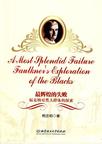最辉煌的失败
出版时间:2009-12 出版社:北京理工大学出版社 作者:鲍忠明 页数:311
前言
1949年诺贝尔文学奖获得者威廉·福克纳(1897-1962)是美国南方作家,也是世界文坛公认巨匠;福克纳研究是国际学界研究重点,在国内也几成显学。美国学界近年推出的有关他的成果几可与莎翁相匹敌,可见其经久不衰之魅力。世纪之交和新世纪之初的福克纳研究未见降温。除了数量庞大的论文和专著外,2002年和2003年的福克纳年会分别聚焦福克纳和他的同代人以及福克纳与南方生态文化的关系。国内自1992年在北大召开了第一届全国福克纳讨论会以来,已举行数次专题学术会议。福克纳的代表作品、评论和传记的中译本相继出版。老一辈译介者中李文俊、陶洁、蓝仁哲、姚乃强等首当其冲,新生代评者中肖明翰、刘建华、何文敬(我国台湾)的研究成果较为突出。近年还有廖彩胜、朱振武分别著书探讨福克纳作品中的语言文化标志和心理美学层面等。此外,每年还有为数众多的论文问世。 我同福克纳结缘最早在20世纪90年代。在安徽师范大学英语系我很幸运地得以追随美籍专家布拉德·博兰(Brad Borain)先生学习美国文学,他虔诚的信仰、高尚的人格、时新的教学手段和意识(他一夜之间在一台机器上产出数十页的文章,当时堪称神奇,我们后来得知那神秘玩意儿是PC286)和严谨的治学态度让我受益终身。博兰先生对《献给爱米丽的一朵玫瑰》的讲解让我欢喜让我忧:喜如威廉·华滋华斯漫步湖边突遇水仙花般享受到巨大的审美愉悦,原来故事竟可以如此立体交叉地叙述,也可以如此开放地去阐释!忧的是如何跟进发展如此迅捷的文学批评潮流,从而能进一步了解、研究这一位颇具神秘色彩的天才作家。很遗憾的是,1991年博兰先生离开中国后我便迷失了方向。 再次接触福克纳已是1999年,那时我考取了安徽大学外国语学院硕士研究生。安徽大学有着怡人的学习环境,外国语学院藏书丰富的阅览室成就了大批英才。在责任导师周方珠教授的要求下,我开始广泛阅读国内外名著,其中就包括福克纳的《我弥留之际》《八月之光》《喧哗与骚动》和《押沙龙,押沙龙!》等。在撰写硕士论文《谁害怕威廉·福克纳:解密(我弥留之际)》时,我细读目标文本达15遍之多,提出“漩涡假说”,受到答辩委员会的好评。但由于没有理论的架构,连自己都觉得这只是一种感性推断。好在读博期间,我终于找到可以支持该假说的互文性理论,写成《处于漩涡隐喻中心的艾迪》一文在北京大学《国外文学》2009年第1期发表。
内容概要
种族主题是美国南方作家——诺贝尔文学奖获得者威廉·福克纳毕生关注的核心问题之一。从《军饷》(1926)到《掠夺者》(1962),福克纳坚持对黑、白种族关系进行思索并对黑人群体进行艺术表现。与此同时,各派别的评家也对小说家的黑人观进行了追踪研究。《最辉煌的失败:福克纳对黑人群体的探索》作者概述了相关主题70年来的批评史,发现现有评论中存在两大问题:一是对作家非代表性作品及其中黑人形象的“歧视”;二是迄今为止尚无一部以小说家全部作品为对象的足本研究。鉴于此,《最辉煌的失败:福克纳对黑人群体的探索》试图通过分析36年间的不同阶段福克纳在社会历史、心理、美学等层面塑造黑人的成就及不足,展现其“抛物线”式架构,并从中得出结论:小说家在这一主题上毕生的努力是“最辉煌的失败”,是一颗“冲突的心灵”苦心孤诣、戏剧化地表现无数“冲突的心灵”的结晶。 《最辉煌的失败:福克纳对黑人群体的探索》由7章组成。第一章 通过解析黑人主题、创作背景和南方作家之间紧张的三角关系,旨在证明只有拥有“福克纳式”天赋和勇气的作家才能冲出重围,实现自己的“文学梦”。作为美学核心的黑人和南方社会对于黑人的敌视与动荡多变为南方作家带来了机遇,也带来了挑战。以福克纳为土要代表的南方作家勇于直面种旗问题,经历了好似将“只撕咬尖叫的猫塞进口袋”一般的痛苦思索和艰难的创作过程,从而促进了“南方文艺复兴”。福克纳则更为神奇地将个双重种族的南方小镇及其故事编织进自己的文学王国——“约克纳帕塌法及之外”。
作者简介
鲍忠明 (1970-),安徽天长人,北京外国语大学英语语言文学博士。研究方向:美国小说及西方现当代文论。现主要从事威廉·福克纳研究,在《国外文学》《山东外语教学》等杂志发表相关论文数篇。
书籍目录
IntroductionⅠ.White ResponseⅡ.African American ResponseⅢ.Chinese ResponseⅣ.Contribution and Organization of the BookChapter One A Tense Triangle: the Blacks, the Sooth and the Artist1.1 The Blacks as the Center of Racial and Aesthetic Concerns1.2 The South as the Center of Turbulent Changes1.3 The Writer as the Center of CreativityChapter Two A Promising Start2.1 An Extensive Awareness of Black Presence2.2 The First Confrontation with a Named Black Family2.3 First Encounter with Mulattoes2.3.1 Mulattoes in Flags in the Dust2.3.2 Mulattoes in "There Was a Queen"Chapter Three A Swift Rise3.1 A Black Family Granted Central Vision3.2 Victim of Sexual Exploitation3.3 Victim of Environment and indian SlaveryChapter Four A Psychological Leap4.1 The First Systematic Demystification of Miscegenation4.2 Dramatization of the Hysterical White Gyneolatry4.3 Dramatization of Black as a "Tainted Idea"4.4 Dramatization of "Blood" MythChapter Five Two Summit Achievements5.1 A Blacks "Encyclopedia"5.2 A Blacks "Manifesto"Chapter Six The Descending Curve6.1 The Descent6.2 The Symptoms6.2.1 The Old Confederate Game Replayed6.2.2 The Deified "Tyrant" and the Mystifying "Nun"6.2.3 The Plummeting to the Ground6.3 Tile Persistent Efforts6.3.1 From Abstraction to Experience6.3.2 From "Watching" to "Doing"Chapter Seven The Limited Faulkner7.1 The Stereotypes Revisited7.2 Intruder in the Text7.3 Neglect of Intra racial RealitiesConclusionBibliography
章节摘录
(Warren 1966, 89). Negroes, who confront the white man from birth to death forgenerations, prove an excellent candidate for the linkage between history and reality. Soin placing his story against southern familial heritage, Fanlkner discovers that, to quoteDavis again, "the Negro is a viable means of relating his major concerns to the past, ofsupplying an additional perspective upon the meaning of that past, and of increasingdramatic tensions between the past and present" (1983, 68). To illuminate the concretefunctions the blacks serve, we need to turn to the black characters themselves. In Flags in the Dust, Negroes get more individualized treatment than in SoldiersPay. Simon, the Sartoris family coachman and butler is described as both "Negro" and"a Negro." In the first place, whether drawn from plantation literature or from thefeatures of one of the Falkner family retainers (Simon is generally thought to owesomething to the Falkner family servant Ned Barnett), Simons portrait has thereassuring face of a black happy with paternalism. He is introduced into the scene withmarvelous affinity with horses and adoration for the Sartorises: Simon sat on the seat with the reins in his left hand and the thong of the whip caught smartly back in his right and usually the unvarying and seemingly incombustible fragment of a cigar in his mouth, talking to the horses in steady, lover-like flow. Simon spoiled horses. He admired Sartorises and he had for them a warmly protective tenderness, but he loved horses, and beneath his hands the sorriest beast bloomed and acquired comeliness like a caressed woman, temperament like an opera star. (FID 8) The impression of a comic black stereotype is enforced a passage away where hedisplays "his races fine feeling for potential theatrics" (ibid), "a typically generalizingremark in this novel," notes Richard Gray, "which, like SP, reduces black people toobjects"(1994, 132). He is physically "Negro." He reeks of "normal odours" (FID 324)and is often cast in animal imagery. "His disembodied head [looks] like that of thecurious and wizened grandfather of all apes"(FID 273),"he scuffed across to the tablewith sounds as of a huge rat (ibid) and during our last view of him, he "look[s] like afrog" (FID 419). He is proud of the Sartoris quality and of being a member of the bestfamily, so much so that he does not open his mouth without mentioning "equipage" and"gentmun" (FID26, 119,120,121). In the same token, he views other "niggers" with"tolerant and easy scorn" (FID 262).
图书封面
评论、评分、阅读与下载
用户评论 (总计0条)
相关图书
- 宋米芾书苕溪诗蜀素帖卷
- 第七届中国书法史论国际研讨会论文集
- 鉴斋丛帖初编(上下)
- 和林格尔汉墓壁画孝子传图辑录
- 古代西域服饰撷萃
- 李正时书法作品集
- 江西省博物馆集刊
- 江山颂
- 中国历代钧瓷釉色
- 幼儿体育特色教育研究与设计
- 甬城现存历代碑碣志
- 张萱《虢国夫人游春图》
- 翰墨萃珍-双松楼藏中国书画精选-两卷
- 长沙东牌楼东汉简牍书法艺术
- 庆祝中华人民共和国成立六十周年共和国部长书画集
- 徐悲鸿作品集(续一)
- 益智幼儿睡前故事·小蝌蚪找妈妈1
- 钟鼎茗香
- 郭沫若致容庚书简
- 西游记·二郎神大战孙悟空
- 西游记·偷吃人参果
- 西游记·黑松林救公主
- 西游记·车迟国斗法
- 西游记·老鼠精逼婚
- 少儿经典有声读物·中华成语故事
